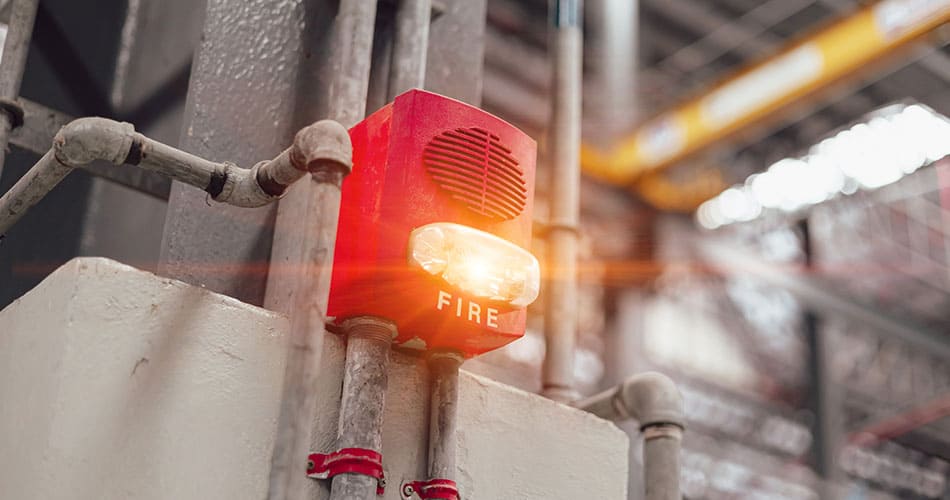Introduction
Whether you're a beginner vaper or been vaping for many years, you may have questioned whether vaping can set off smoke or fire alarms. In this guide we look at the differences between smoke alarm designs, and fire alarm systems to identify their potential of triggering due to vapour created by electronic cigarettes.
By the end of this guide, you will have a much greater understanding of smoke alarms and the potential vaping can have around them with actionable ways to prevent setting them off when in a setting where vaping is permitted, but still has them installed.
It's important to highlight that we do not promote or endorse vaping in public places where it is prohibited to do so. For more information on laws and regulations surrounding vaping please be sure to check out our vaping in public places guide.
Never tamper with, disable, or cover a smoke or fire alarm. By doing so you may compromise your safety and others around you in the event of a fire. Always put your safety first and explore other solutions found within this guide.
Summary: Vaping can set off smoke and fire alarms, mostly Ionisation and optical designs. You should not vape anywhere you're not permitted to do so, although if you have permission to vape indoors, ensure there is adequate ventilation and you are vaping on a lower setting or with a vape kit that creates minimal vapour paired with higher PG e-liquid instead of heavy VG based liquids. If unsure or concerned, wait until you can vape away from alarms, or look at smokeless alternatives such as nicotine pouches.

Smoke alarms vs fire alarms
You may have heard of smoke alarms and fire alarms, but did you know there is a difference between the two, which also affects the possibility of them picking up on vapour from e-cigarettes and cigarette smoke?
Smoke alarms simply work by detecting smoke, fire, or heat. There are multiple designs which we will discuss further, although each one works independently unless connected to a centralised system. On the other hand, fire alarms encompass many devices that offer more than just detecting smoke which welcomes a great difference between the two.
Generally fire alarms are connected to multiple building devices to widely spread alert throughout a building or site when a fire is detected. Fire alarms generally consist of multiple smoke alarms throughout a building where each one is best suited. One key difference between the two is that fire alarm systems are generally connected to electrical mains instead of relying on batteries to offer the highest level of protection.
Types of smoke and fire alarms
There are three main types of smoke alarms commonly used throughout households and public buildings such as hotels, pubs, restaurants, including places of work. Each is designed to detect fire in different ways either focusing on ionisation, optical, or heat to detect fire and other potential dangers.
Below we discuss each design in more detail with how they can act around vaping so you can gain a greater understanding of how each alarm works and whether you should be cautiously vaping around them. Please note, that we strongly advise against vaping anywhere that it is prohibited. Always check with property owners or management for their vaping policy.
Ionisation alarms
Ionisation smoke alarms work by ionising the air between two electrically charged plates. This type of alarm is activated when anything disrupts the current between the two plates, such as smoke. Ionisation alarms are less sensitive to vapour created by electronic cigarettes, however, they can still be triggered by vaping, especially denser clouds created by more powerful devices such as sub ohm vape kits.
Optical alarms
Optical smoke alarms function by using an infrared light to detect smoke. When particles break this light beam within the alarm, it causes the light to be scattered which will then trigger the alarm.
Optical alarms can be triggered by e-cigarette vapour in the same way Ionisation alarms can, although once again this is generally only the case with larger vapour exhales from more powerful devices. In addition, shortfill e-liquid used with these devices has a higher Vegetable Glycerine (VG) ratio which creates a thicker vapour more prone to set off smoke alarms.
Heat alarms
Mostly used within kitchen and garage environments, heat alarms are one of the least likely smoke or fire alarms to be triggered by vaping. These alarms respond to hot air created by fire. Once this hotter air enters the sensor chamber, most commonly 50°C or higher, the alarm will trigger. Although your coil will heat up to a higher temperature, the vapour exhaled should not set off a smoke alarm.

Does vaping set off smoke alarms?
The short answer is yes, vaping can set off smoke alarms but there are exceptions. Vapour created by e-cigarettes can trigger a smoke alarm, most commonly an ionisation or optical alarm. These two popular smoke alarm designs can easily confuse vapour for smoke due to their similar density. However, with this said, the chances of vaping and setting off a smoke alarm depend on many other factors.
If you're vaping a more powerful device that's capable of producing more vapour, or using e-liquids with a higher VG ratio such as shortfills, then the chances of triggering a smoke alarm greatly increase. Although disposable vapes and pod kits create less vapour, there is still a possibility of setting off an alarm, especially an optical or ionisation design.
How to vape without setting off a smoke alarm
When it comes to vaping indoors where smoke alarms are in place, it can become annoying having to worry about the possibility of triggering the alarm. Although we do not advise vaping in public places where it is prohibited, there are many areas where vaping may be permitted but still have smoke detectors in place.
Even if you have permission, vaping in a room with a smoke alarm could cause it to go off. We would always advise vaping in a designated area away from any smoke detectors and where you have authorisation to do so.
If you do have permission but the area is within reach of a smoke alarm, then below we highlight the best ways to avoid setting off a smoke alarm when vaping indoors.
Different E-Liquid
E-liquid that contains a higher ratio of VG produces a thicker vapour overall which can increase the chances of setting off a smoke alarm. If you're vaping this type of e-liquid, most commonly found in shortfills then it may be best to switch to a higher PG e-liquid such as freebase 10ml e-liquids or nic salts, although make sure you match these with the right device and settings for the best vaping experience.
Adjust Vape Settings
If you're using a vape kit that offers adjustments, such as a traditional pod kit or sub ohm kit, it may be worth lowering the power setting to minimise vapour production. The higher the wattage of your device, the greater amount of vapour you will produce, which in turn can increase the chances of triggering a smoke alarm.
Proper Ventilation
Smoke alarms should be installed on ceilings unless instructed otherwise as fire and heat rises. Ensure that you are not blowing vapour directly upwards, or in the direction of the installed smoke alarm to minimise triggering it. In addition, having open windows, fans, or air conditioning can increase ventilation and break down the vapour to reduce risk of setting off a smoke detector.
Different Vape Device
Lower-powered vape devices such as disposables, or starter kits produce smaller amounts of vapour which is less likely to set off a smoke alarm, especially when compared to more powerful devices such as sub ohm kits. However, if doing so, it's still important to ensure that you have adequate ventilation and to avoid blowing vapour directly toward a smoke alarm.
Smokeless Alternative
If your vape is still triggering a smoke alarm, or you're worried about vaping in a room that has one active, then your last option is to look at vaping alternatives that are smoke-free such as nicotine pouches. Although you will not gain the same sensation, pouches or other forms of Nicotine Replacement Therapy (NRT) can at least suppress your nicotine cravings until you can vape once more.

Can vapes set off fire alarms?
Fire alarms utilise many type of smoke detectors in their systems which means that vaping could potentially set off a fire alarm. Unlike a single smoke alarm, setting off a fire alarm due to smoking or vaping when you're not permitted to do so can lead to fines from the likes of hotels or other risks if done so in your place of work.
We do not advise vaping indoors where you are not permitted to do so. Even if you have permission, vaping in close proximity to a fire alarm could cause it to be triggered and is not worth the risk. If you need to vape then we advise doing so in a designated area away from any fire alarms.

Conclusion
You should now have a much greater understanding on how smoke alarms and fire prevention systems work and what may happen if vaping around them. Although each have their differences in design and capabilities, it's clear that there is potential to set off the majority of smoke alarms if adequate vapour is detected in a badly ventilated room.
If you want to vape indoors where it is permitted and cannot do so in a room that doesn't have a smoke alarm installed, the best course of action is to ensure that the room is well ventilated and you are using a lower powered vape device and e-liquid with a higher PG ratio instead of heavy VG based e-liquids such as shortfills.
Frequently asked questions (FAQ)
Vapes can trigger a smoke alarm if it has the ability to do so. Although they may not set off a heat alarm, those with a ionisation or optical sensor can mistake vapour for smoke and trigger the alarm.
Fire alarm systems may use smoke detectors and alarms as part of their system, if so they can potentially detect vapour from e-cigarettes.
Vapour created from electronic cigarettes can set off a smoke alarm, especially if it is an ionisation or optical design, although vapes may struggle to set off a heat alarm.
Vapour from an e-cigarette can trigger a fire alarm if it comes into contact with a smoke detector or alarm. Never vape indoors if you are not permitted to do so. If permitted, avoid blowing vapour towards the smoke alarm and ensure the room is well ventilated.
Yes, vapes can set off smoke alarms found inside hotels and other public premises including workplaces. You should not vape in a hotel room unless you are permitted to do so.
Although disposable vapes such as Elf Bar and Lost Mary produce small amounts of vapour, they can still set off smoke alarms, especially ones that utilise ionisation or optical designs.
|
Resources: |
|---|
Disclaimer: The content on www.royalflushvape.co.uk offers general insights about vaping and vape related products. Please be aware that this information is not meant to be a substitute for medical advice and should only be relied upon when explicitly referenced. We make no guarantees regarding the accuracy, reliability, or health-related advantages of the content displayed across all pages of our website, including blog posts, product pages and social media content.



